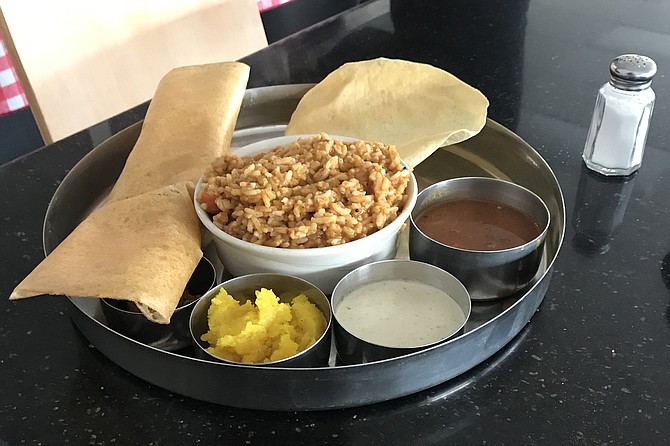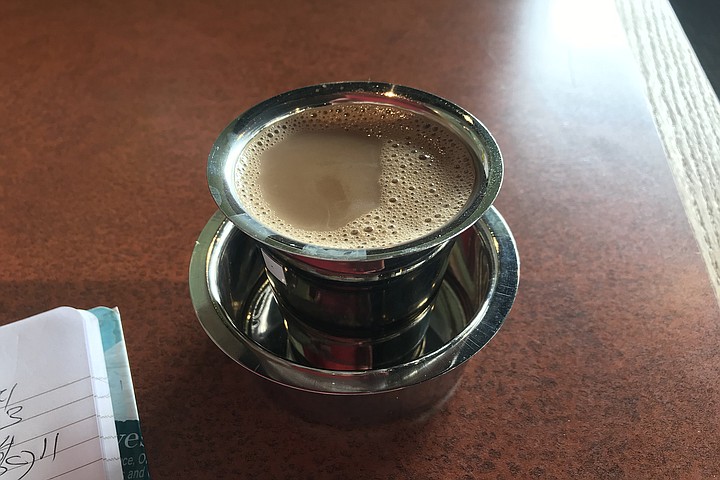 Facebook
Facebook
 X
X
 Instagram
Instagram
 TikTok
TikTok
 Youtube
Youtube

Little India. Black Mountain Road. Looking for an Indian grocery outlet. Gotta find my new favorite flavor to swipe on bread. Marmite. Surprise for my friend Annie. She’s Scottish. She let me try some of hers. It has a beefy flavor. So I’m looking, looking. Pass by a place called Chennai Tiffins. Chennai? Ancient city on the east coast of India. Used to be called Madras. Old? Has been populated the last, oh, 250,000 years. Hmm. I just might come back for, well, tiffin.
Tiffin’s what the Indians of India call light lunch, or a savory afternoon tea. As it happens, right now would be perfect timing for tiffin. Around two.

Except I’m still looking for this grocery outlet, Akshar Cash ‘N’ Carry. I dodge around car wrecks at “Ability Auto Body & Paint,” and hey, now I spot a place hidden in the corner called “San Idli.”
“‘San Idli?’” I ask the guy, Natrajan.
“It means ‘San Diego Idli.’ We are famous for idli.”
Huh. Idli. Now he’s got my curiosity going.
“Yes,” he says. “South Indian food. I am from Telangana, the 29th state in India. Vegetarian. Please.”
He motions me in. Some Indian businessmen, looks like, are nearing the end of their meal. Turns out lunch is over in twenty minutes, 2:30. Cook’s cleaning up a steaming hot plate in the open kitchen. Natrajan shows me the menu. Hmm. I’m not so up as I should be on Indian cuisine. I know they have their own Mason-Dixon Line, gastronomically speaking. If you wanna break down the difference between northern and southern Indian food, north is meat and bread, south is vegetarian and rice. That’s it. Plus north: lots of yogurt and cream; south, coconut milk.
So, here we’re looking at southern cookin’ all the way. Lot of new words to take in. Thank goodness Natrajan’s hovering. (Sneak check shows “Natrajan” means “King of Dance.” It’s all about Shiva. I think Natrajan’s dancing a little because in fifteen minutes, they’re outta here.)

First up is vada. Two for $5.99. “They’re like fritters, cutlets, doughnuts, dumplings,” says Natrajan. Or for $4.99, they have sambar vada. “A lentil-based veggie stew,” says Natrajan.
Oh man. This is a long list of stuff I know nothing about. Only item I recognize is samosa, the triangular fried pastry pockets of veggies or meat for $1.99 each. But mirchi bhaji (two for $3.99)? Papad chat (two for $2.99)? It’s all French to me. And hey, four items down, 50 to go on the menu.
One word I do notice coming up a lot is this “Idli.” Like “mini sambar idli” gives you ten for $5.99. Sounds like good value, but ten what?
“Idli are lentil-rice cakes,” says Natrajan. “Very popular for breakfast with sambar, the soup, or chutneys.”
In the end I retreat to the part that says “Weekday lunch special (11 am-2:30 pm).” So for $11.99, you get one of four kinds of rice (lemon, tamarind, sambar, or curd), a mini masala dosa (this I remember: a big, thin, rolled crepe with potato inside), or mini vegetable uthapam (“a thicker dosa,” says Natrajan), plus “idli, sambar, pickle, papad, chutney, dessert.”
“I’ll take it,” I say, because we’re seriously running out of time.

The round tray has the sambar (I chose it because it’s the spiciest) with steaming flavored rice in the middle, the dosa (thank goodness it’s the mini version. Full-size is like an umbrella), the sambar veggie soup, a bowl of coconut milk chutney, a crispy chickpea papadum, and a little bowl of biting raw green mango pickle. So this must all be good for you, right? Vegetarian, slightly spicy, all fresh-cooked?
Natrajan says the name of the game is dipping, and pouring over. So I start off with the dosa and dunk it into the sambar soup. Get a nice umami flavor from the mash inside, and specially when I add a chunk of mango pickle. But the best flavors come when you pour the sambar over the spicy rice, and then add a pour of the coconut chutney, then take a crackling chomp of the chickpea papad. Then a slurp of tea (I got me one, $2.99. Mmm. Rich flavors — cardamom? — and hey, India is where tea comes from, so it should be interesting). Whatever, what a combo!
Oh, and hidden beneath the dosa, this restaurant’s namesake, an actual idli. Like a mini flying saucer of compressed lentil-rice just waiting to be dipped.
Natrajan says idli cakes are made by steaming the batter of fermented black lentils and rice. I know fermentation is great because it breaks down starches and makes them easy to digest. Idli are supposed to be incredibly good for you.
“Save the rava kesari till last!” says Natrajan as he starts closing up. He’s pointing at what looks like a blob of sticky rice. Turns out it’s semolina, yellow - “kesari” means “saffron” - and it’s really sweet. And OMG, it goes with this tea like a horse and carriage.
So value for money? Oh yes. How actually healthy it all is? Jury’s still out. Heckuvalot of fried stuff, boiled stuff, not much sign of green stuff. But this vast, ancient cuisine, it is completely vegetarian. That’s a lot of eaters voting with their mouths.
I do finally find my Marmite, at Akshar Cash ‘N’ Carry. Just around the corner. “I wouldn’t show it at the restaurant,” says Annie when I call.
“Why not?”
“It’s made from beef, you dingbat.”


Little India. Black Mountain Road. Looking for an Indian grocery outlet. Gotta find my new favorite flavor to swipe on bread. Marmite. Surprise for my friend Annie. She’s Scottish. She let me try some of hers. It has a beefy flavor. So I’m looking, looking. Pass by a place called Chennai Tiffins. Chennai? Ancient city on the east coast of India. Used to be called Madras. Old? Has been populated the last, oh, 250,000 years. Hmm. I just might come back for, well, tiffin.
Tiffin’s what the Indians of India call light lunch, or a savory afternoon tea. As it happens, right now would be perfect timing for tiffin. Around two.

Except I’m still looking for this grocery outlet, Akshar Cash ‘N’ Carry. I dodge around car wrecks at “Ability Auto Body & Paint,” and hey, now I spot a place hidden in the corner called “San Idli.”
“‘San Idli?’” I ask the guy, Natrajan.
“It means ‘San Diego Idli.’ We are famous for idli.”
Huh. Idli. Now he’s got my curiosity going.
“Yes,” he says. “South Indian food. I am from Telangana, the 29th state in India. Vegetarian. Please.”
He motions me in. Some Indian businessmen, looks like, are nearing the end of their meal. Turns out lunch is over in twenty minutes, 2:30. Cook’s cleaning up a steaming hot plate in the open kitchen. Natrajan shows me the menu. Hmm. I’m not so up as I should be on Indian cuisine. I know they have their own Mason-Dixon Line, gastronomically speaking. If you wanna break down the difference between northern and southern Indian food, north is meat and bread, south is vegetarian and rice. That’s it. Plus north: lots of yogurt and cream; south, coconut milk.
So, here we’re looking at southern cookin’ all the way. Lot of new words to take in. Thank goodness Natrajan’s hovering. (Sneak check shows “Natrajan” means “King of Dance.” It’s all about Shiva. I think Natrajan’s dancing a little because in fifteen minutes, they’re outta here.)

First up is vada. Two for $5.99. “They’re like fritters, cutlets, doughnuts, dumplings,” says Natrajan. Or for $4.99, they have sambar vada. “A lentil-based veggie stew,” says Natrajan.
Oh man. This is a long list of stuff I know nothing about. Only item I recognize is samosa, the triangular fried pastry pockets of veggies or meat for $1.99 each. But mirchi bhaji (two for $3.99)? Papad chat (two for $2.99)? It’s all French to me. And hey, four items down, 50 to go on the menu.
One word I do notice coming up a lot is this “Idli.” Like “mini sambar idli” gives you ten for $5.99. Sounds like good value, but ten what?
“Idli are lentil-rice cakes,” says Natrajan. “Very popular for breakfast with sambar, the soup, or chutneys.”
In the end I retreat to the part that says “Weekday lunch special (11 am-2:30 pm).” So for $11.99, you get one of four kinds of rice (lemon, tamarind, sambar, or curd), a mini masala dosa (this I remember: a big, thin, rolled crepe with potato inside), or mini vegetable uthapam (“a thicker dosa,” says Natrajan), plus “idli, sambar, pickle, papad, chutney, dessert.”
“I’ll take it,” I say, because we’re seriously running out of time.

The round tray has the sambar (I chose it because it’s the spiciest) with steaming flavored rice in the middle, the dosa (thank goodness it’s the mini version. Full-size is like an umbrella), the sambar veggie soup, a bowl of coconut milk chutney, a crispy chickpea papadum, and a little bowl of biting raw green mango pickle. So this must all be good for you, right? Vegetarian, slightly spicy, all fresh-cooked?
Natrajan says the name of the game is dipping, and pouring over. So I start off with the dosa and dunk it into the sambar soup. Get a nice umami flavor from the mash inside, and specially when I add a chunk of mango pickle. But the best flavors come when you pour the sambar over the spicy rice, and then add a pour of the coconut chutney, then take a crackling chomp of the chickpea papad. Then a slurp of tea (I got me one, $2.99. Mmm. Rich flavors — cardamom? — and hey, India is where tea comes from, so it should be interesting). Whatever, what a combo!
Oh, and hidden beneath the dosa, this restaurant’s namesake, an actual idli. Like a mini flying saucer of compressed lentil-rice just waiting to be dipped.
Natrajan says idli cakes are made by steaming the batter of fermented black lentils and rice. I know fermentation is great because it breaks down starches and makes them easy to digest. Idli are supposed to be incredibly good for you.
“Save the rava kesari till last!” says Natrajan as he starts closing up. He’s pointing at what looks like a blob of sticky rice. Turns out it’s semolina, yellow - “kesari” means “saffron” - and it’s really sweet. And OMG, it goes with this tea like a horse and carriage.
So value for money? Oh yes. How actually healthy it all is? Jury’s still out. Heckuvalot of fried stuff, boiled stuff, not much sign of green stuff. But this vast, ancient cuisine, it is completely vegetarian. That’s a lot of eaters voting with their mouths.
I do finally find my Marmite, at Akshar Cash ‘N’ Carry. Just around the corner. “I wouldn’t show it at the restaurant,” says Annie when I call.
“Why not?”
“It’s made from beef, you dingbat.”